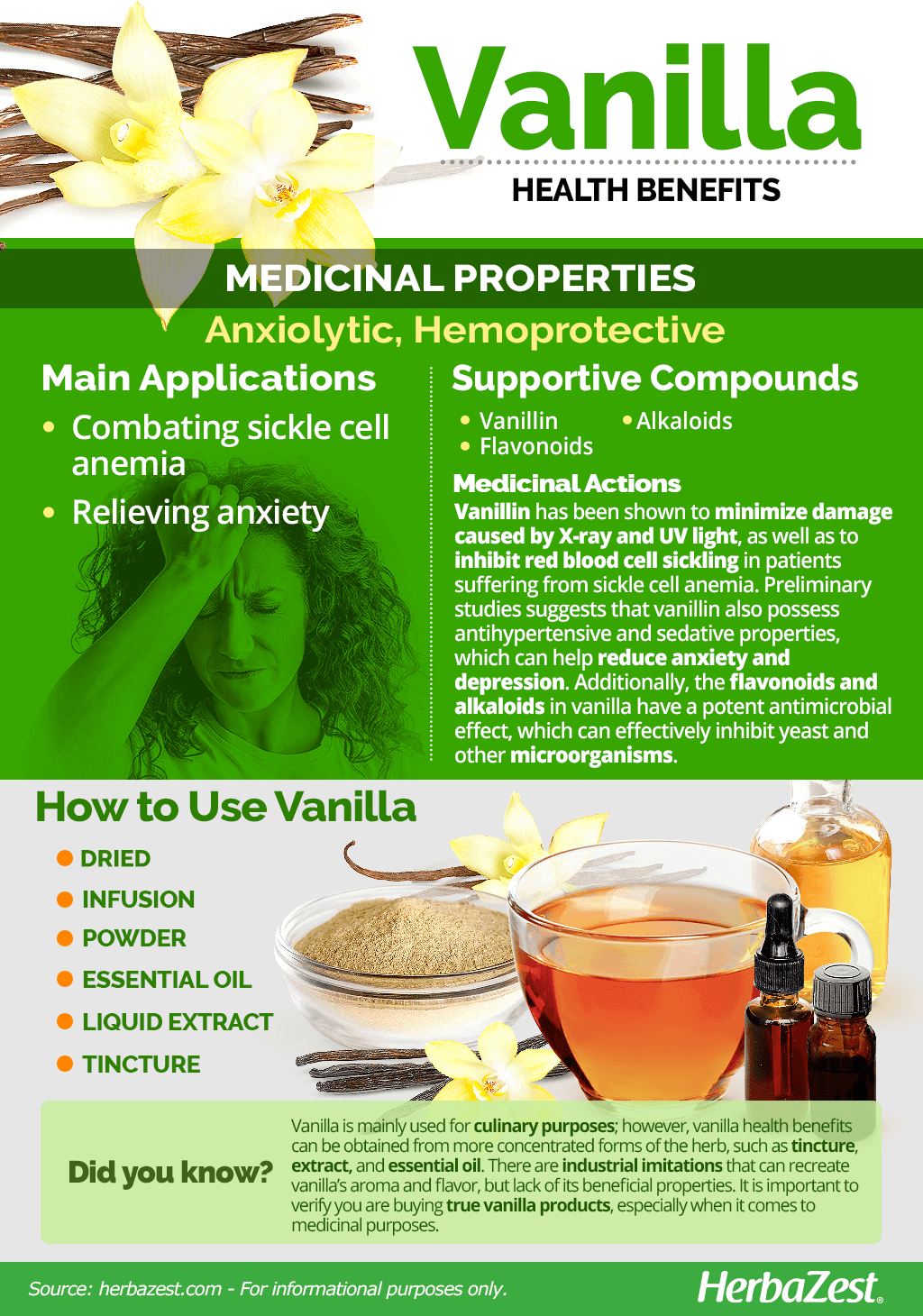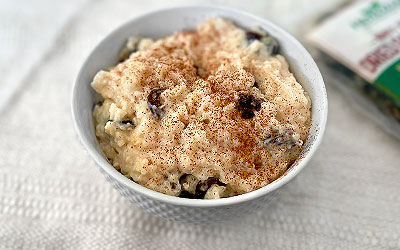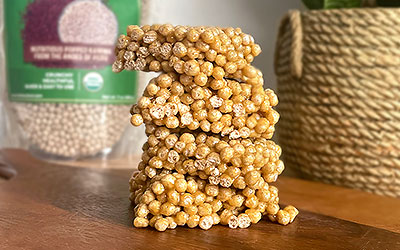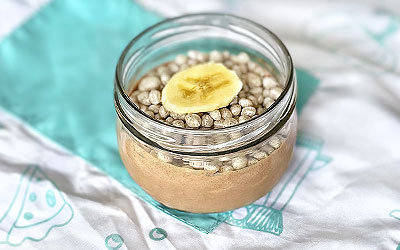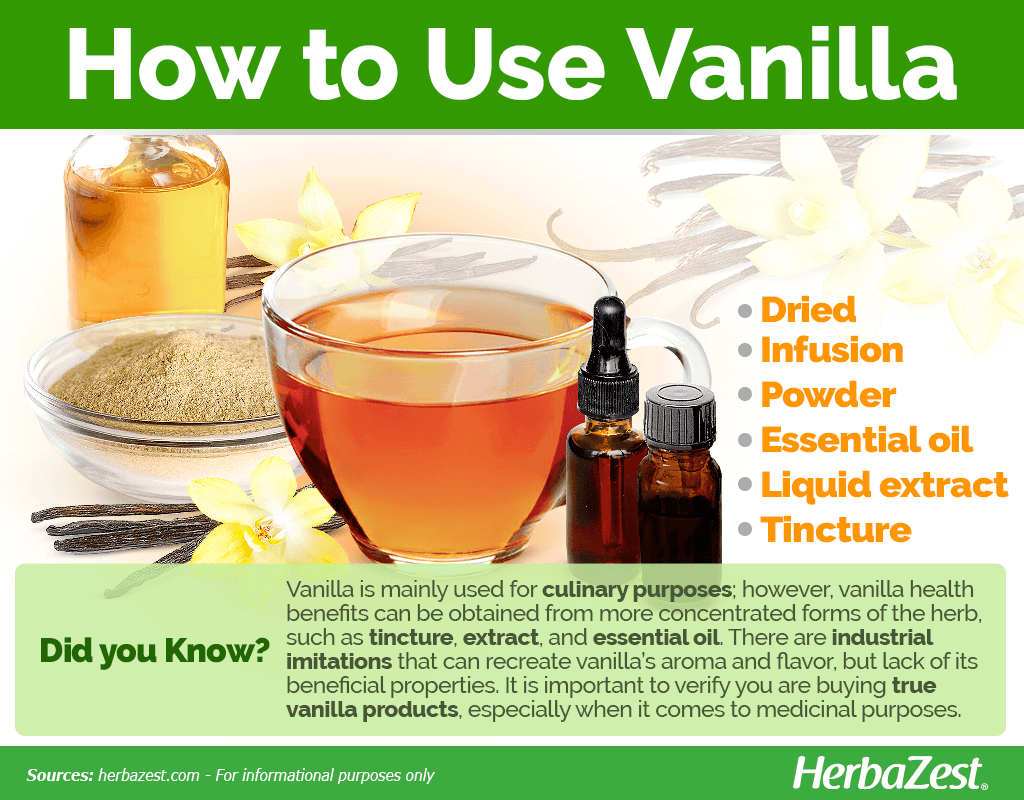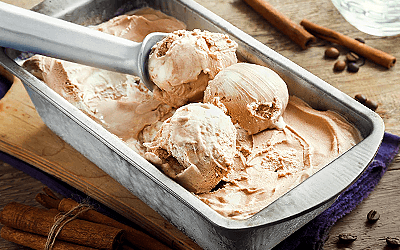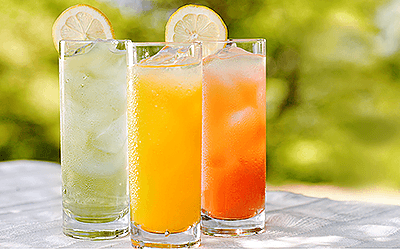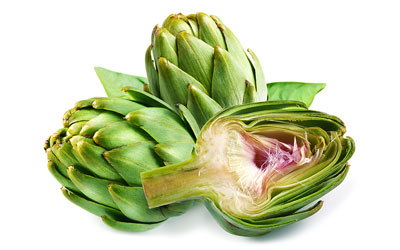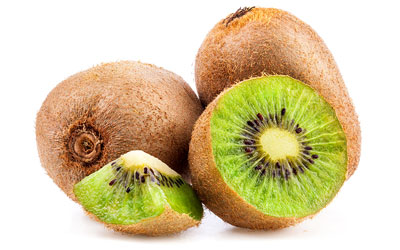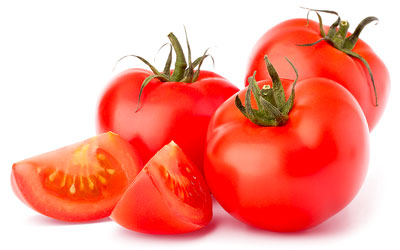The vanilla plant is native to Central America, particularly Mexico, Guatemala, and Panama. Highly valued for its culinary uses in chocolate preparations, baked goods, and beverages, little-known is the fact that, for centuries, vanilla has also been regarded as an aphrodisiac, carminative, and stimulant herb. While it is still widely popular as a flavoring agent and aromatic herb, scientific studies keep revealing new vanilla properties that may help treat and prevent common health conditions.
Vanilla Medicinal Properties
- Medicinal action Anxiolytic, Hemoprotective
- Key constituents Vanillin, flavonoids and alkaloids
- Ways to use Hot infusions/tisanes, Liquid extracts, Tincture, Powder, Essential oil, Dried
- Medicinal rating (1) Very minor uses
- Safety ranking Safe
Health Benefits of Vanilla
Better known as an aromatic plant of great culinary importance, vanilla health benefits have been reaped for centuries in its native lands. Scientific studies have shown and documented the medicinal properties of vanilla, being the most important ones:
Combating sickle cell anemia. Vanilla possess hemoprotective properties, which help prevent cellular degradation in sickle cell anemia.
Relieving anxiety. In concentrated, medicinal forms, the main compounds of vanilla have been shown to play a role in the central nervous system (CNS), reducing anxiety and mild depression.
Vanilla is also known for its ability of lowering blood pressure, as well as for its antispasmodic and antimicrobial properties, which are thought to be helpful for cough relief, dental caries prevention, and nausea.
Vanilla has been used for centuries in folk medicine for treating loss of appetite, fevers, and digestive troubles, as well as an aphrodisiac and stimulant, although its effectiveness in these cases has not been validated by scientific studies.
Traditionally, vanilla has been considered an aphrodisiac and it was also believed to reduce fever.
How It Works
Vanillin is the most essential component of the over 200 compounds present in the vanilla beans. Vanillin is not only responsible for the characteristic aroma and flavor of vanilla beans, but also possess anticlastogenic properties, which minimize chromosome damage caused by X-ray and UV light, and it has been reported to effectively inhibit red blood cell sickling in patients suffering from sickle cell anemia.
When fermented for many days at a time, the glucosides found in vanilla decompose into glucose, vanillin, and other aromatic chemicals, creating its unique flavor or scent, well known for its relaxing action. In preliminary studies, vanillin has shown antihypertensive and sedative properties, which lead to an antidepressant effect by influencing the activity of the central nervous system (CNS) in a similar way as fluoxetine, a popular drug for treating depression.
Additionally, the flavonoids and alkaloids contained in the vanilla bean have shown an inhibitory action against bacteria. Studies have confirmed that both leaf and stem extracts of vanilla have a potent antimicrobial effect over yeast and other microorganisms.
There are industrial imitations of vanilla that can recreate its aroma and flavor, but lack of its beneficial properties.
Herbs like papaya and garlic have been shown useful for treating sickle cell anemia, whereas anxiolitic and antidepressant properties can be found in passion flower and lemon balm.
Vanilla Side Effects
When consumed in normal amounts used in food, vanilla is considered mostly safe. However, sensitive individuals may experience skin irritation or inflammation from topical applications. Additionally, when medicinal forms of vanilla are consumed for a long time, they can cause headaches or insomnia.
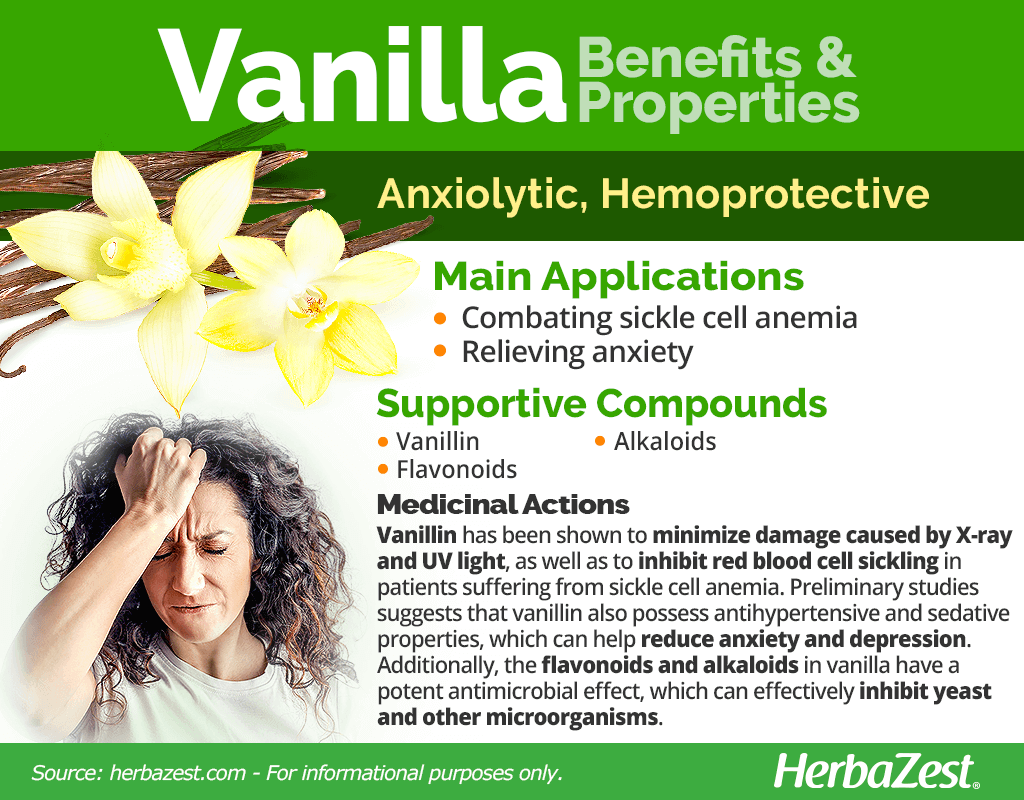
How to Consume Vanilla
- Edible parts Flowers, Stem
- Edible uses Flavoring
- Taste Aromatic
Although vanilla is not sweet, it has been traditionally used in Europe and North America as an ingredient in sweet preparations, such as cakes, puddings, ice cream, liquors, and many others. In Africa the opposite occurs, and vanilla is mainly employed to flavor savory dishes.
Vanilla is mainly used for culinary purposes, and as a nutraceutical ingredient for many products. However, vanilla health benefits can be obtained from more concentrated forms of the herb, such as tincture, extract, and essential oil.
Natural Forms
Dried. Actual vanilla pods are uncommon and expensive, but they provide high quality flavor; simply slice the pod and scrape out the hundreds of tiny black seeds within for culinary or medicinal purposes.
Infusión. Some vanilla properties, such as relaxant and carminative effects, as well as the soothing fragrance of this aromatic herb, can be obtained by steeping dried vanilla beans in hot water for few minutes.
Powder. Vanilla powder is widely used for bakers and the alimentary industry as a flavoring agent. It is also present in many nutritional supplements.
Herbal Remedies & Supplements
Liquid extract. While most vanilla extracts in the market are synthetic flavoring agents and don't offer the medicinal properties of vanilla. Pure vanilla extract is less common and mostly used for culinary purposes, but it also provides some of the relaxant and antimicrobial benefits of vanilla.
Essential oil. Because of its high concentration of vanillin, the essential oil extracted from vanilla beans is widely used in aromatherapy for lowering anxiety and induce relaxation.
Tincture. Obtained from the maceration of vanilla pods in a neutral alcohol solution (like vodka), this preparation can be used as a flavoring ingredient for cooking, as an antimicrobial agent for topical use, or as a mild sedative when diluted in a glass of water.
Growing
- Life cycle Perennial
- Harvested parts Flowers, Seeds, Leaves, Stem
- Light requirements Partial shade
- Soil Well-drained
- Growing habitat Tropical rainforests
- Growing time 5 years
- Propagation techniques Cuttings
- Potential diseases Root rot
The vanilla plant is notoriously difficult to grow. Even in its native lands of Central America, particularly Mexico, only 1% of blossoms are naturally pollinated because they remain open for one day at a time, and only a certain type of bee and hummingbird can pollinate the vanilla vine.
Taking into account the short window of opportunity and the small numberof natural pollinators, it is remarkable that vanilla was as prominent as it was found to be in the Aztec culture.
Growing Guidelines
The vanilla plant requires the moist, tropical climates around the equator with temperatures around 80°F (26°C), and it grows about 2,000 feet (600 m) above sea level.
Because vanilla grows in the dense undergrowth of tropical areas, the vine will climb up neighboring trees by means of adaptable, aerial roots in order to obtain enough sunlight for photosynthesis.
In its natural environment, the vanilla plant can reach as high as 75 feet (23 m).
The vanilla vine can be cultivated through cuttings, and it takes about five years until it reaches fruitful maturation, though flowers will form by the third year.
The vanilla vine starts producing fruit only when it is mature, generally larger than 10 feet (3 m).
The vanilla plant is susceptible to root rot, due to the humidity and high temperatures of its native lands.
Hand pollination requires checking for new flowers every day during the two-month blooming season and pressing the pollen masses into the stigma of the flowers, lest the flower wilt and die within 8 - 12 hours.
After pollination, a pod will grow within six weeks; however, the maturation process takes about five months. A single vanilla vine can produce up to 100 pods per year.
After the vanilla beans are harvested, they go through a process of fermentation followed by a drying period, in order to keep the most of their essential oils.
A trained pollinator can fertilize 1,500 flowers in one day, but must be careful not to pollinate too many of them on a single vine, since doing that may kill it.
Additional Information
- Other uses Cosmetics, Perfume, Repellent
Plant Biology
The vanilla plant is a beautiful evergreen vine, with plentiful and stout leaves between 6 - 9 inches (15 - 22 cm), which climbs and attaches to tree trunks and other supports by its fleshy roots. Native to South East Mexico, Guatemala, and Panama, vanilla grows in the tropical zones of the equator around the world.
The vanilla vine produces yellow or cream or green trumpet-shaped flowers, about two inches (5 cm) in diameter, last only one day and must be hand-pollinated to produce a seedpod, the "vanilla bean”, which is about 6 - 9 inches (15 - 23 cm) long.
Classification
The scientific name of the vanilla vine is Vanilla planifolia (Syn. Vanilla fragrans) and it is a member of the Orchidaceae family. Of all orchids, the members of the Vanilla genus are the only ones that produce an agriculturally valuable crop.
Varieties and Subspecies of Vanilla
Out of the total 110 species of vanilla, only three of them have commercial importance: Vanilla planifolia, Vanilla tahitensi and Vanilla pompona. However, commercial vanilla beans are obtained mainly from Vanilla planifolia, which is the source of 95% of the world's production.
Historical Information
In 1518, Hernán Cortés and his fellow Spanish conquerors brought vanilla to Europe, where it quickly became popular as an aphrodisiac, sedative, and stomach-soother. However, vanilla was kept from spreading as a crop due to the incredible difficulty of pollinating the plant.
THE NÁHUATL WORD FOR VANILLA IS "TLILXOCHITL", IN REFERENCE TO THE DARK COLOR OF ITS DRY PODS, WHICH THE AZTECS CONSIDERED AS FOOD OF THE GODS.
It has even been suggested that the Aztecs manually pollinated the vanilla blossoms in order to preserve the species - a practice that wasn't discovered in modern times until 1841 and continues today. It was Edmond Albius, a 12-year-old slave on the French colony of Réunion, in the Indian Ocean, who discovered how to manually pollinate the plant by hand, at which time vanilla production began to proliferate in other tropical areas.
Economic Data
Vanilla beans are cultivated in many areas of the world and the main producing countries are Madagascar, Indonesia, China, Comores and in a lesser extent Tonga, Reunion, Turkey and Guadeloupe. Ever since commercialization began, about 175 years ago, Madagascar has supplied about 70% of the world's vanilla. In Mexico, the main producing area is located in the Totonacapan, located in the northern part of the state of Veracruz.
A one of the most costly spices in the world, vanilla is only beat out by saffron in terms of expense, thanks to its tedious cultivation requirements and relative rarity. The fermentation process of the vanilla beans is quite laborious; they require several hours in the sun and then are repeatedly wrapped and contained in boxes to sweat for 36 days. During this time, they turn from yellow to black. Afterwards, the pods are thoroughly dried, chopped, and soaked in ethanol to produce commercial extract. Only 2,200 metric tons of vanilla beans are commercialized each year, and they reached the price of 275 USD per pound (605 USD per kg) as recently as 2004.
Currently, imitation vanilla extract accounts for 95% of the world's supply.
Other Uses
Aromatherapy. Most commonly, vanilla is used as a scent in candles, incense sticks, and essential oils. The vanilla fragrance is associated with relaxation, calming the nerves, and stimulating the senses, sometimes used as a soothing aromatherapy for patients undergoing MRI and CAT scans.
Industrial. Vanilla is also used as a flavoring and aromatizer agent in beverages, tobacco and pharmaceutical products. The fragrance of vanilla makes is often used for masking unpleasant odors.
Cosmetics. Vanilla scent is highly valued in the industry of cosmetics and perfumes; however, synthetics fragrances are often used as a substitute of the expensive pure vanilla oil or extract.
Repellent. it is said that spiders are averse to vanilla, making the pods useful as a natural repellent.
Sources
- Anemia, Traditional Herbal Management of Sickle Cell Anemia: Lessons from Nigeria, 2012
- Antioxidant Properties of Spices, Herbs and Other Sources, pp. 581-585
- Indian Journal of Pharmacology, Evaluation of antidepressant activity of vanillin in mice, 2013
- Indian Journal of Science and Technology, Antimicrobial activity of Vanilla planifolia, 2009
- International Journal of Pharmaceutical Sciences Review and Research, Vanilla Planifolia: A Review of a Plant Commonly Used as Flavouring Agent, 2013
- National Tropical Botanical Garden, Vanilla planifolia
- Palomar College, Orchid Family: Orchidaceae, Vanilla Orchid (Vanilla planifolia)
- Phylogeny and Classification of the Orchid Family, 1993
- QJM: An International Journal of Medicine, The uses and misuses of orchids in medicine, 2005
- University of California, Vanilla
- University of Wisconsin, Vanilla planifolia: A Food of the Gods, Now and Forever.
- FAOSTAT, VANILLA Post-harvest Operations
- Kew Royal Botanic Gardens, Vanilla planifolia (vanilla)
